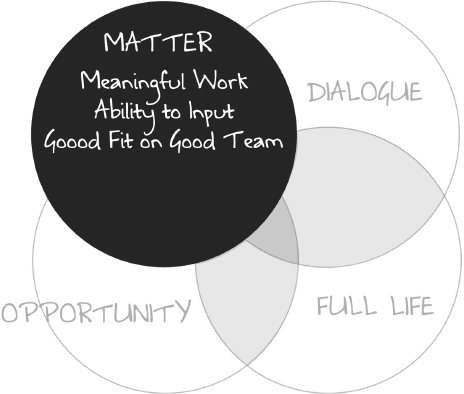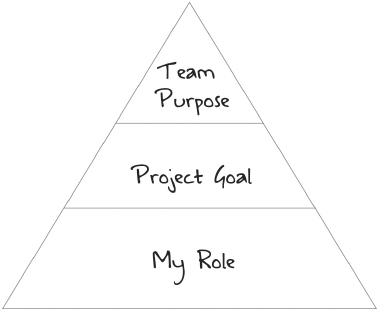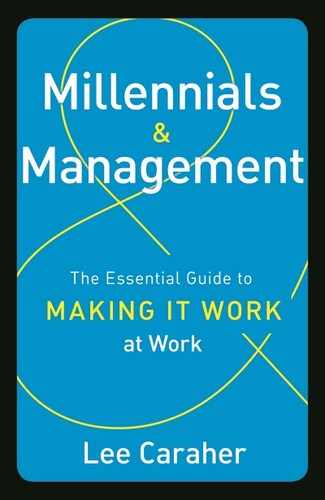4
Making Work Meaningful
“Just because” isn’t going to work for me.
—Liz, age thirty

Why can’t they just do what I tell them to?”
Gone are the good old days, when “Because I told you to” was a useful or sustainable workplace tool. It might work once, but assume that icy stare or rolling of the eyes means that Joe is looking for a new job, and you’ll soon be starting all over again training his replacement. And while it might seem better to replace the eye-roller, it’s a costly slippery slope of extra time exiting one person and recruiting and onboarding a new one. And high turnover drives down productivity and morale.
The replacement cost is more than just the 16 to 20 percent of salary that is widely held as the estimated cost of turnover per person. Add your stress level and extra uncompensated hours to get the job done, and you can start to figure out the personal toll that replacing your team members before it is time takes on you.
Understanding the bigger picture is vital to getting started with a task, never mind doing the work well. Millennials have been conditioned to know that they can make a difference and that their presence is important. They want to understand how they make a difference in their work. And they want to be confident that what they do matters: that it matters to the team, to the company, to the bottom line, and to the vision. They want to understand how what seems mundane can possibly be important.
This, of course, flies in the face of what many older managers experienced as they moved up the ladder. “No one ever told me why I was doing the work—they just told me to do it, and I did,” says Chris.
How dumb were we? Very.
I remember feeling bewildered about work tasks I didn’t understand the relevance of, and when I figured it out—usually by myself—the lightbulb would go on and all of the sudden I’d be able to do things faster and better.
“My” Place Here
We all want to know how we fit into the big picture and what that big picture is. It’s not enough to provide a clear vision for why our company exists, even though that is very hard to do well. Equally important is being able to describe what your team’s role in that vision is, and how we each contribute to the team and therefore the vision. And you must reinforce this constantly.
Menial, entry-level work is the toughest to swallow for many recent college graduates. “It’s a shock when they get a job and realize what entry-level really means,” says Susan. “The attitude seems to be ‘I don’t want to do this’ and ‘I get it—and I want to do something important now.’ And when reality hits them, they get bitter.”
While earning your way up isn’t dead, not understanding how and why bottom-level work fits into the bigger picture is a dead horse we can keep wasting our time beating, but it’s not coming back to life. If you want a chance at keeping entry-level Millennials in the fold long enough for them to learn the ropes and become more productive and valuable to you, providing context for their jobs is critical, not optional.
What is this task for? Why does it matter? How does learning this task help with learning the next one? How is this not like calculus that you’ll probably never use again? How does this stupid work fit into the more “important” work everyone else is doing? I’m going to say it now, and I’ll say it again, you cannot overcommunicate this information for people from any generation, ever.
The Big Picture: Vision and Purpose
Unless you’re on the founding team or are the CEO, you may not have had a role in creating the vision and mission for your company. But you should know it, breathe it, work it.
The business bookshelf is full of guides on creating a vision and mission that everyone can remember, embrace, and repeat. If you don’t already have a clear mission in place, get one. Following are a few books that will help you articulate your business vision and mission:
- The Story of Purpose by Joey Reiman
- It’s Not What You Sell, It’s What You Stand For by Roy M. Spence Jr.
- Start with Why by Simon Sinek
My process is built on lots of years of helping companies articulate a compelling vision and mission that differentiates them from competitors in the category. And, because my brain is small, it’s a pretty simple process that works for every kind of company, from retail operations to personal or corporate service firms, and from consumer packaged goods companies to religious institutions.
Answer these questions:
- We work for: interesting description of target market
- Who want/need to: verb describing condition, desire, or need
- In a world that/where: describe current condition you’re solving for
Example:
Acme Voice Talkers
We work for: young boys struggling with severe speech disorders
Who need to: be able to communicate
In a world where: not being able to be understood significantly limits opportunity
The Medium Picture: The Purpose of My Team
The big picture is not enough—teams need clarity on how their department or group fits into the big picture. And they need to know how their teams are a part of accomplishing the specific mission that’s in front of them.
Answer these questions:
- What does this department, group, or team do that is vital to the company?
- If we weren’t here what would happen?
- If we weren’t here what wouldn’t happen?
My Picture: The Role of the Individual
Make sure your staff understands the value of their positions and how they fit into the larger whole. They should be able to answer these questions:
- This job exists to:
- My job is to make sure that:
- If I wasn’t here, this is what wouldn’t happen:
This last step, the individual’s immediate picture—why “I” make a difference—is critical. It may seem excessive, I know, but if people understand their purpose within the bigger vision, if they can tie their day-to-day work to making a difference, then work goes a bit smoother and more efficiently, with better output and good morale all the way around.
While we talk to outsiders and business partners about the company’s big picture, we’re better off talking to employees in terms of the pyramid’s base being the person, not the company. It’s true that we all ladder up to something bigger, but it’s more effective to make the person the most “important” part of the pyramid when explaining how the work fits into the bigger purpose. This is true for Millennials as well as for those in your organization from other generations.

Invert the traditional pyramid for employees so they can understand how their work fits into the company’s mission.
When managers talk with people individually, they should convey to each person how the different parts of his job ladder up to the company’s reason for existing.
Sometimes people ask, “But Lee, doesn’t this just feed into the problem?” No. This cures the problem. By creating a through line from individuals to the company vision and mission, you will give people a much clearer sense of why they, and by extension their work, matters.
Say it once, then say it again. Lather, rinse, and repeat. And repeat. And repeat.
How to Drive the Point Home
You may feel like a broken record (of course, some of your younger staff may not even know what that means) but you cannot overcommunicate what your company, your team, and each person is there to do, and what difference the person, the team, and the company will make in the world.
Use Onboarding to Introduce Purpose
Start at the beginning—day one, week one—with an onboarding process that includes an in-depth look at the company, the team, and the role. By the end of the first week, new employees should know more than where the water cooler is—they should be able to articulate how they fit into the team and how their work will advance the mission of the company.
Reset Teams with New People
When new people come onto your team, it’s a good practice to reset the team so that everyone is clear on how the new person fits in. Take thirty minutes during a team meeting when you’ve added a new member to remind everyone about the vision and mission of the company, and how the team fits in. Show an organizational chart of how the team fits into the company or division. Detail the team’s organizational chart so everyone has a clear view of how the new member adds to the strength of the team. Have each person articulate his role on the team so that the new person hears it—and so that team members reinforce what they know. Course correct if you need to, so no one leaves the meeting with a misconstrued idea of her own or someone else’s role.
Expand Job Descriptions
Often, job descriptions focus exclusively on the job at hand and do not put the job in the context of the team. Expand your job descriptions so that each role is tied to a team’s purpose and the company vision on paper. By including this context in the job description, you will make sure everyone understands how she fits in. (Don’t forget to make sure that everyone has a copy of her job description.)
Provide Color and Context for Projects
“I never had to be told what was expected of me. Why don’t they know, like we did?” asks Carol.
They don’t. They just don’t. Millennials have been overdirected since childhood, so many of them expect to be given guidelines; in the absence of those guardrails, they answer the question or complete the assignment in a shallow way that is often insufficient for the task at hand.
The primary source of dissonance in organizations is conflicting assumptions between and among teams and/or team members, regardless of age. How often do you hear comments like, “I didn’t know that,” “I thought I was supposed to …” or “Weren’t you going to … ?” Frustration is inevitable when we don’t check assumptions and expectations and drive clarity into our language before the work starts. To be successful and efficient and to help make our teams successful and efficient, we need to meet them where they are, not do things that just continue to create disappointment and frustration.
While management consistently believes they have given clear, unambiguous direction, what many Millennials—and others on the team, for that matter—may hear are ambiguous, loose suggestions, creating recurring frustration for management.
I heard many versions of Andrew’s complaint that if his manager had “only told me why the report mattered, and who it was going to, I would have done it differently.” It shouldn’t matter. But you can stop hitting your head against the wall and save yourself some time and a headache by just providing context every time you assign a project or task.

As you start new projects, do not assume that everyone understands the impetus for the project or his role in it. Take fifteen to twenty minutes at the beginning to talk through the full context and purpose of the project—discussing at the outset how each person will contribute and what the dependencies among people and tasks are saves a lot of time and questions later. E-mail this description to the whole team too, so if someone forgets you can refer her to the e-mail instead of stopping to explain again.
Of course, you may get “I don’t understand why it has to be done this way.” Truthfully, I’ve learned that my people are finding better ways to do things all time. However, I ask them to do it my way once and then to suggest a different path to the same goal. This way, when they come back with new ideas I can talk with them about the specific steps and what they learned so I can be sure they understand the full context of the work at hand.
Once people of any generation understand how their work, however dull it may seem, matters to the team, they become more engaged, more active, and more thoughtful about it. Accountability increases when someone understands how his performance impacts the rest of the team’s work and ultimately the office’s or company’s. Indeed, I’ve found that nothing conveys insufficient work more than the question “do you understand how you let the team down?”
All work matters, or you wouldn’t need it to be done. Now it’s just a question of making sure the people doing the work get it too.
Making a Difference Through Work Too
Beyond making a difference at work with meaningful work, Millennials want to make a difference through their work—in their communities and in the world at large — as well. Millennials want their companies to be active volunteers and contributors and to provide opportunities for them.
As reporter Laura Meckler articulated in The Wall Street Journal, Millennials "want to work for companies with public service missions. They want their employers to contribute to social and ethical causes." Meckler’s bottom line, based in part on the work of Morley Winograd and Dr. Michael Hais who believe that Millennials are very likely to be steadfast in seeking to align their beliefs with their work, is exciting (for me) and cautionary for all of us: "[I]f the values of the Millennial generation hold up over time, corporate America may be in for a shock."And by corporate America, I think we mean all business: from the small business with fewer than ten employees, to the Fortune 100 with tens of thousands of people around the country. Companies that don’t actively engage in their communities will be at a disadvantage in recruiting and retaining the strongest and broadest base of Millennials.
So there’s no time like the present to jump in and articulate how your business will participate in the community: here's a few ways to jumpstart your thinking and doing:
- Employee Match: Offer to match your employees' donations to non-profit organizations (by percentage of their total give or capped). You can decide to focus the company's giving in certain areas (sustainability, housing, food, etc. or leave it open).
- Find one to three nonprofits that make the differences most aligned with your company mission and focus your company donations, time, and talent to advancing their causes.
- Instead of gifts to your clients at the end of the year, donate to a nonprofit in their area in their names. At Double Forte, employees nominate different charities which we then vote on, and we donate the money we would have spent on client gifts to that winning organization in our clients' names.
- Help your employees in their volunteer efforts. Many of your employees are active volunteers in a wide range of worthy causes—there are lots of ways to help them help others. Offer up your office for committee meetings. Allow employees to e-mail the staff about volunteer opportunities with their charities (runs, clean up days, concerts etc.)
- Focus team days on volunteer activities—use a service like VolunteerMatch to find great opportunities for your team to team-build while helping organizations in your community with team days that put your people to work where their ideas and elbow-grease are needed most.
Long-term you want a policy or framework and a budget (and you'll want to measure and report too!) but there’s no time like the present to start making a bigger impact in your world now—and helping attract, retain, and excite your current and future employees.
Management Dos and Don’ts
- Do share your vision for your company, your team, and yourself—often. Explain how your company makes a positive difference.
- Do explain how everything you do is tied to the mission of the team and company. What may seem mundane is important—explain how and why.
- Do onboard new employees and new team members deliberately, taking the time to explain the vision and values of the company and how that new individual can make a difference.
- Do reset the team every time you add or lose a new person.
- Don’t assume people understand how their role fits into the bigger picture.
- Don’t assume that if you say it once it will sink in. You cannot—I repeat, you cannot—overcommunicate this stuff.
- Do save yourself a lot of time by taking the time at the beginning of any project to explain the purpose of the project and how each team member will contribute.
- Do actively engage in helping the community around you: find ways to help your employees regularly help worthy organizations.
Millennial Dos and Don’ts
- Do know that no one is going to employ you for work that doesn’t matter.
- Do ask how you fit in, if you don’t know.
- Do perform tasks your supervisor’s way at least once before you suggest a new way.
- Don’t assume leadership knows all the technical shortcuts you do; be prepared to show others when you describe new ways of doing things so they can understand that you’re not cutting corners.
- Do come ready for your first week with the questions you need to understand the role you’ve just accepted.
- Do participate in your company’s volunteer activities. If your company does not have volunteer activities, find your own and seek ways to engage your team.
